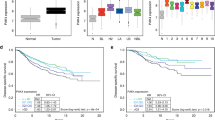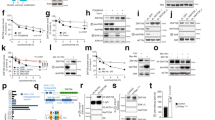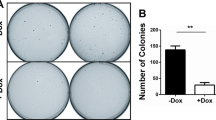Abstract
Overexpression of Ras(V12) in MCF10A cells, an immortalized mammary epithelial cell line, leads to transformation of these cells. We demonstrate that this is accompanied by degradation of C/EBPbeta1. C/EBPbeta is a transcription factor in which three protein isoforms exist because of alternative translation at three in-frame methionines. When C/EBPbeta1 is expressed in MCF10A-Ras(V12) cells, immunoblot analysis reveals that C/EBPbeta1 is degraded in these cells. Treatment of MCF10A-Ras(V12)-C/EBPbeta1 cells with the cdk inhibitor roscovitine leads to stabilization of C/EBPbeta1. It has been previously shown that cdk2 phosphorylates C/EBPbeta on Thr235. We demonstrate that mutation of Thr235 to alanine in C/EBPbeta1 is sufficient to restore the stability of C/EBPbeta1 expression in MCF10A-Ras(V12) cells. Overexpression of Ras(V12) in primary cells induces senescence rather than transformation, thus suppressing tumorigenesis. C/EBPbeta is required for Ras(V12)-induced senescence in primary mouse embryonic fibroblasts. Upregulation of interleukin-6 (IL6) by C/EBPbeta has been shown to be necessary for oncogene-induced senescence, but the specific isoform of C/EBPbeta has not been investigated. We show that the C/EBPbeta1 isoform upregulates IL6 when introduced into normal fibroblasts. In addition, we show that C/EBPbeta1 induces senescence. Taken together, degradation of C/EBPbeta1 by Ras activation may represent a mechanism to bypass OIS.
This is a preview of subscription content, access via your institution
Access options
Subscribe to this journal
Receive 50 print issues and online access
$259.00 per year
only $5.18 per issue
Buy this article
- Purchase on Springer Link
- Instant access to full article PDF
Prices may be subject to local taxes which are calculated during checkout






Similar content being viewed by others
References
Bundy LM, Sealy L . (2003). CCAAT/enhancer binding protein beta (C/EBPbeta)-2 transforms normal mammary epithelial cells and induces epithelial to mesenchymal transition in culture. Oncogene 22: 869–883.
Bundy L, Wells S, Sealy L . (2005). C/EBPbeta-2 confers EGF-independent growth and disrupts the normal acinar architecture of human mammary epithelial cells. Mol Cancer 4: 43.
Calkhoven CF, Muller C, Leutz A . (2000). Translational control of C/EBPalpha and C/EBPbeta isoform expression. Genes Dev 14: 1920–1932.
Campaner S, Doni M, Hydbring P, Verrecchia A, Bianchi L, Sardella D et al. (2010). Cdk2 suppresses cellular senescence induced by the c-myc oncogene. Nat Cell Biol 1: 54–59.
Descombes P, Schibler U . (1991). A liver enriched transcriptional activator protein, LAP, and a transcriptional inhibitory protein, LIP, are translated from the same mRNA. Cell 3: 569–579.
Dunn KL, Espino PS, Drobic B, He S, Davie JR . (2005). The Ras-MAPK signal transduction pathway, cancer and chromatin remodeling. Biochem Cell Biol 83: 1–14.
Eaton EM, Hanlon M, Bundy L, Sealy L . (2001). Characterization of C/EBPbeta isoforms in normal versus neoplastic mammary epithelial cells. J of Cell Physiol 189: 91–105.
Eaton EM, Sealy L . (2003). Modification of CCAAT/Enhancer-binding protein-beta by the small ubiquitin-like modifier (SUMO) family members, SUMO-2 and SUMO-3. J of Biol Chem 278: 33416–33421.
Grignani F, Kinsella T, Mencarelli A, Valtieri M, Riganelli D, Lanfrancone L et al. (1998). High-efficiency gene transfer and selection of human hematopoietic progenitor cells with a hybrid EBV/retroviral vector expressing the green fluorescence protein. Cancer Res 58: 14–19.
Hanlon M, Sturgill TW, Sealy L . (2001). ERK2- and p90Rsk2-dependent pathways regulate the CCAAT/Enhancer-binding protein-beta interaction with serum response factor. J of Biol Chem 276: 38449–38456.
Hydbring P, Bahram F, Su Y, Tronnersjö S, Högstrand K, von der Lehr N et al. (2010). Phosphorylation by Cdk2 is required for Myc to repress Ras-induced senescence in cotransformation. Proc Natl Acad Sci USA 1: 58–63.
Iavarone A, Massague J . (1997). Repression of the CDK activator Cdc25A and cell-cycle arrest by cytokine TGF-beta in cells lacking the CDK inhibitor p15. Nature 387: 417–422.
Koslowski M, Tureci O, Biesterfeld S, Seitz G, Huber C, Sahin U . (2009). Selective activation of trophoblast-specific PLAC1 in breast cancer by CCAAT/enhancer binding protein beta (C/EBPbeta) isoform 2. J of Biol Chem 284: 28607.
Kowenz-Leutz E, Leutz A . (1999). A C/EBPbeta isoform recruits the SWI/SNF complex to activate myeloid genes. Mol Cell 4: 735–743.
Kuilman T, Michaloglou C, Vredeveld L, Dourma S, van Doom R, Desmet CJ et al. (2008). Oncogene-induced senescence relayed by an interleukin-dependent inflammatory network. Cell 133: 1019–1031.
Li X, Woo Kim J, Gronborg M, Urlaub H, Lane MD, Tang Q . (2007). Role of cdk2 in the sequential phosphorylation/activation of C/EBPbeta during adipocyte differentiation. Proc Natl Acad Sci USA 104: 11597–11602.
Malaney S, Daly R . (2001). The Ras signaling pathway in mammary tumorigenesis and metastasis. J of Mam Gl Biol And Neopl 6: 101–113.
Musgrove EA . (2006). Cyclins: roles in mitogenic signaling and oncogenic transformation. Growth Factors 24: 13–19.
Robinson GW, Johnson PF, Hennighausen L, Sterneck E . (1998). The C/EBPbeta transcription factor regulates epithelial cell proliferation and differentiation in the mammary gland. Genes and Development 12: 1907–1916.
Seagroves T, Krnacik S, Raught B, Gay J, Burgess-Beusse B, Darlington G et al. (1998). C/EBPbeta, but not C/EBPalpha, is essential for ductal morphogenesis, lobuloalveolar proliferation, and functional differentiation in the mouse mammary gland. Genes and Development 12: 1917–1928.
Sebastian T, Malik R, Thomas S, Sage J, Johnson PF . (2005). C/EBPbeta cooperates with RB: E2F to implement Ras (V12)-induced cellular senescence. EMBO J 24: 3301–3312.
Shuman JD, Sebastian T, Kaldis P, Copeland TD, Zhu S, Smart RC et al. (2004). Cell cycle-dependent phosphorylation of c/ebpbeta mediates oncogenic cooperativity between C/EBPbeta and H-RasV12. Mol And Cell Biol 24: 7380–7391.
Uematsu S, Kaisho T, Tanaka T, Matsumoto M, Yamakami M, Omori H et al. (2007). The C/EBPbeta isoform 34-kDa LAP is responsible for NF-IL-6-mediated gene induction in activated macrophages, but is not essential for intracellular bacterial killing. J of Immunol 179: 5378–5386.
Zhu S, Yoon K, Sterneck E, Johnson PF, Smart RC . (2002). CCAAT/enhancer binding protein-beta is a mediator of keratinocyte survival and skin tumorigenesis involving oncogenic Ras signaling. Proc Natl Acad Sci USA 99: 207–212.
Acknowledgements
We thank Maria Abreu, Kim Boelte, Linda Bundy, Alisha Russell and David Vaught for insightful suggestions and Rachel Jerrell for technical assistance. We thank Gary Nolan (Standford University) for LZRS-BMN-lacZ and Phoenix cells, Scott Lowe (Cold Spring Harbor) for pBABE-Ras(V12)-puromycin, Hal Moses (Vanderbilt University) for WI-38 fibroblasts and S. Akira for CMV-NF-IL6-T235A. We also thank Cathy Alford in the Veterans Affairs flow cytometry core (Nashville, TN) for technical assistance. This work was funded by NIH GM69634 and by the Cell Biology and Molecular Sciences training grant.
Author information
Authors and Affiliations
Corresponding author
Ethics declarations
Competing interests
The authors declare no conflict of interest.
Additional information
Supplementary Information accompanies the paper on the Oncogene website
Rights and permissions
About this article
Cite this article
Atwood, A., Sealy, L. Regulation of C/EBPbeta1 by Ras in mammary epithelial cells and the role of C/EBPbeta1 in oncogene-induced senescence. Oncogene 29, 6004–6015 (2010). https://doi.org/10.1038/onc.2010.336
Received:
Revised:
Accepted:
Published:
Issue Date:
DOI: https://doi.org/10.1038/onc.2010.336
Keywords
This article is cited by
-
Antagonistic TSC22D1 variants control BRAFE600-induced senescence
The EMBO Journal (2011)
-
Oncogene-Induced Senescence and its Role in Tumor Suppression
Journal of Mammary Gland Biology and Neoplasia (2011)



